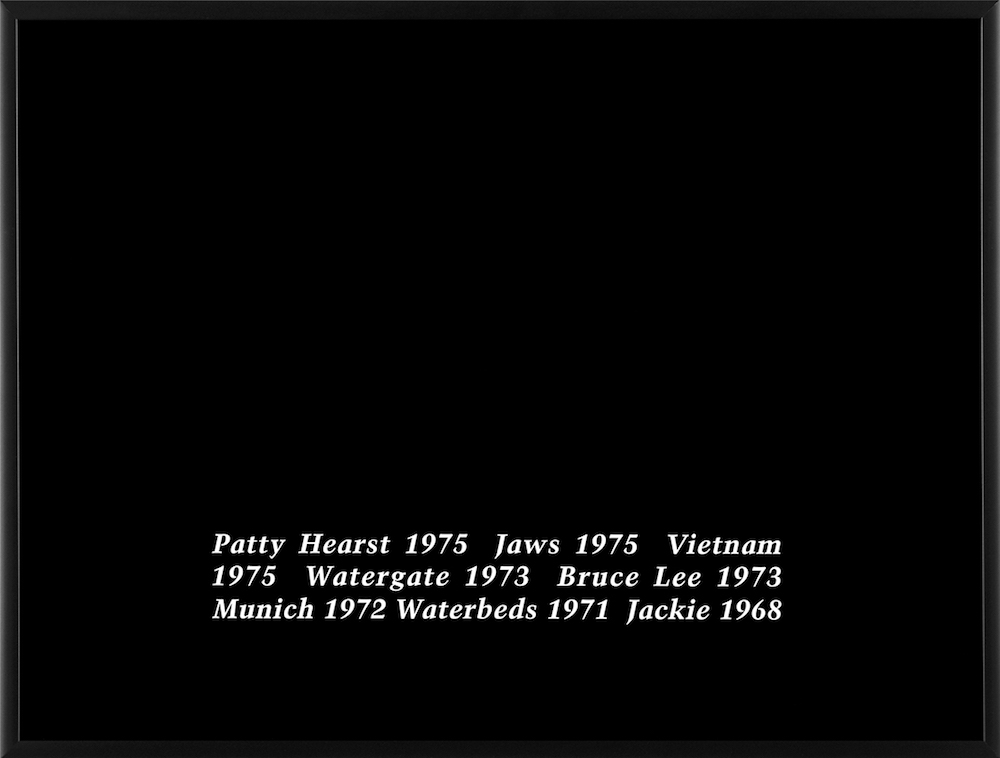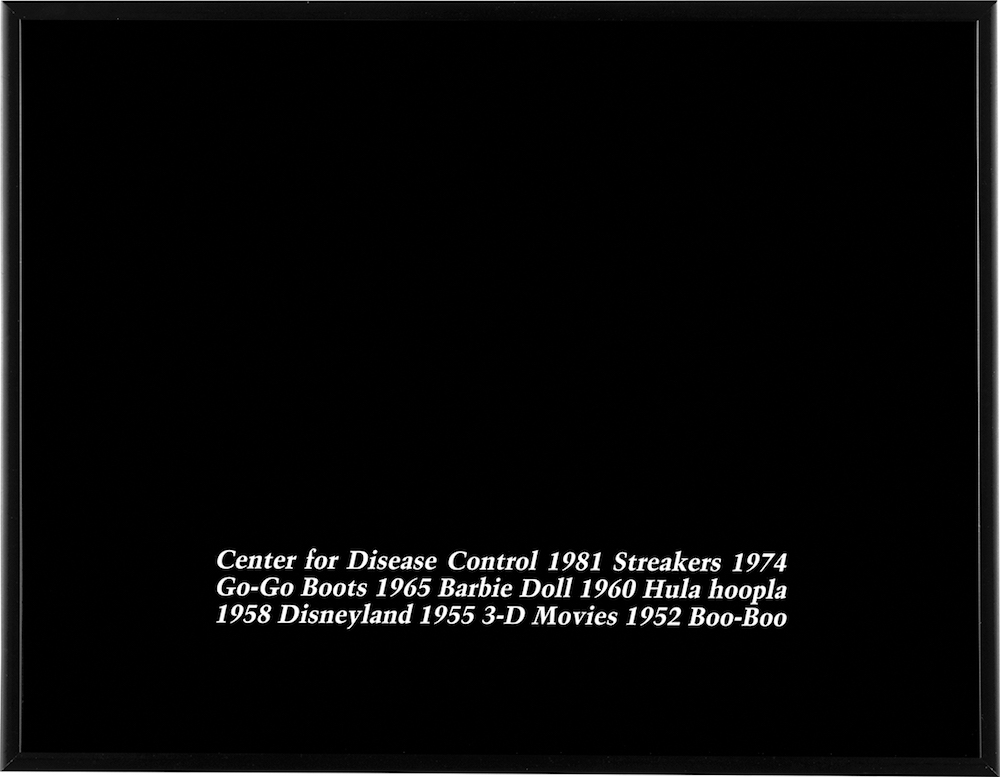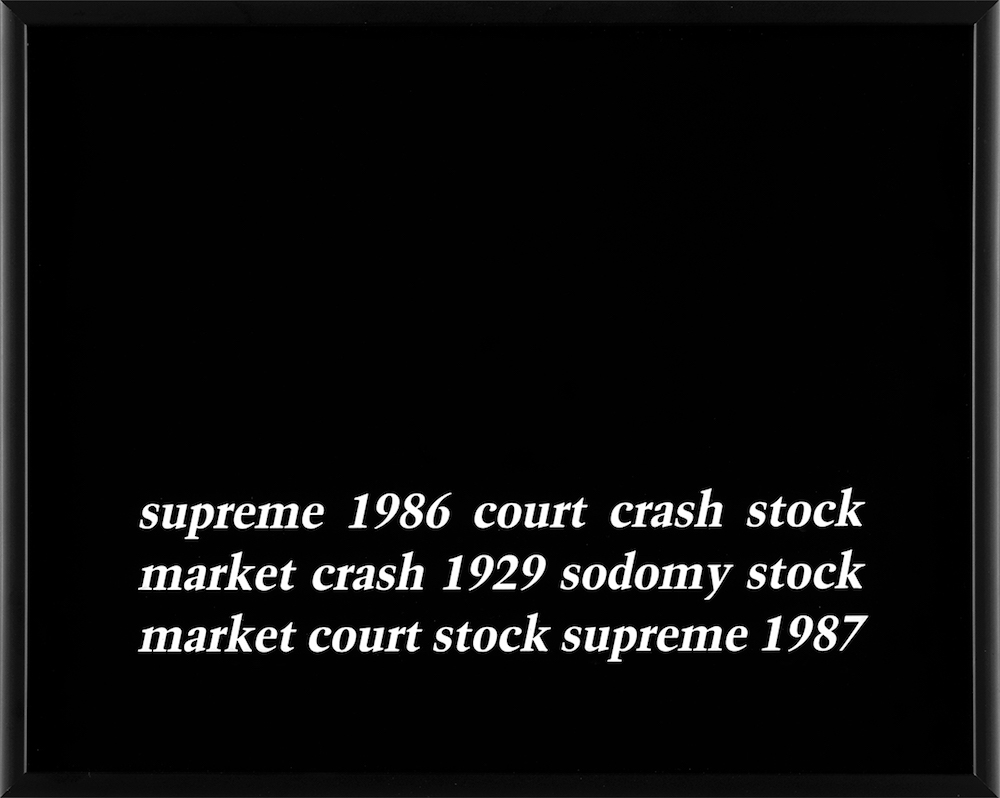
“Untitled”, 1988 by Felix Gonzalez-Torres, framed photostat, 10 1/4 x 13 inches. Published in Photostats, Siglio, 2020. Copyright Felix Gonzalez-Torres. Courtesy Felix Gonzalez-Torres Foundation.
Time the substantial we, / epochal and great, as only we can see it, our particular.
—Alice Notley
No one wants to be defined by history’s contingencies, by catastrophe, but attempting to ignore how they shape us would be as ludicrous as trying to stop the clock. What if instead we broke down the chain of events leading to them, undoing their fatal sequence and leaving their parts open for reassembly? Is this what’s at stake in Felix Gonzalez-Torres’s photostat works? In the book Photostats, they appear as coded messages awaiting decipherment, but they’re equally apt on gallery walls as reminders that no matter how open or walled-off any space may be, it escapes neither interconnectedness nor time’s inexorable march.
Unlike the stars, we do not write, luminously, on a dark field (Mallarmé). Yet Gonzalez-Torres’s inscriptions do act as constellations, as celestial alphabet. Events worth remembering, the count of years—they are light beams orienting us as we go on forgetting. Each cluster of dates and references displays its own oblique associative logic. The larger narrative it may or may not point to can be searingly legible or obscure to varying degrees. Regardless, those gaps between elements in each of the clusters are openings inviting us to fill in the blanks by bringing in our own associations, personal histories, and biases.
I took apart dates and historical events and remembered or discovered what occurred then that might have had a bearing on him. Let’s not forget he was a transplant, a politically minded one, who identified specifically as American but was born in Cuba and raised in Puerto Rico: two places with a complex relationship to the U.S. I wonder with whom in the art world he would’ve spoken in Spanish and how his conversations would’ve taken shape according to what he’d say in one language and not the other. Did he think of this? Am I projecting? He carefully avoided labels.
Apropos of not making art about being gay, Gonzalez-Torres said to Ross Bleckner in a BOMB interview that his work was about love and infiltration. “It’s beautiful; people get into it. But then, the title or something, if you look really closely at the work, gives out that it’s something else.” To look closely at Gonzalez-Torres’s photostats involves taking a deep dive into history’s ash heap, getting lost in the process, knowing there’s no one way to read the works. Oddly rhyming shards emerge, resonant shards that seem to prove the existence of a universe in which the future’s already happened.
*
Lest Chile become “another Cuba,” the Nixon administration encourages a military coup against the democratically elected Salvador Allende in the early seventies. Weeks after Allende’s overthrow in 1973, the Weather Underground bombs the ITT Corporation’s offices in New York and Rome for its involvement in the coup. In 1974 Hans Haacke makes an artwork exposing the Guggenheim Museum’s trustees’ ties to the Kennecott Copper Corporation and its attempts to undermine Chile’s economy after Allende’s regime expropriated its mines. In 1975, a killer shark in a film symbolizes a miscellany of sociopolitical anxieties. A Gonzalez-Torres exhibition opens at the Guggenheim in 1995.
*
In 1983, Bowie asks an MTV host: “I’m just floored by the fact that there are so few black artists being featured … Why is that?” One of 285 music videos featured that year is in Spanish: the Italian disco duo Righeira’s “No tengo dinero.” In 1985, the Organization of Volunteers for the Puerto Rican Revolution claims responsibility for shooting a U.S. Army recruiting officer: “Yankee jails are becoming filled with … our patriots; … prepare your cemeteries because we’re going to fill them with your mercenaries.” In 1987, Harvard University is awarded the first new-life-form patent for the cancer-prone, transgenic oncomouse.
*
In 1975, Cambodia’s new leadership embarks on a gruesome path toward self-reliance and “clearing the country of the filth and garbage left behind by the war of aggression of the US imperialists and their lackeys.” In 1968, the U.S. Embassy is attacked in Rio. Student uprisings against autocratic regimes, and the sentiment leading Peruvian students to shower Vice President Nixon with garbage while on a goodwill tour a decade earlier, sweep across Latin America. In the 1987 Robocop, a cyborg is developed after a self-sufficient robot designed for Detroit’s urban pacification kills a trustee of the very corporation that created it.
*
There’s a video by Felix Gonzalez-Torres made in 1979, the year he arrived in the U.S. and portable music was born. Shirtless, he speaks to the camera in Spanish while writing on a blackboard. He remembers being put on a plane to Spain with his sister as a child. Remembers priests and not remembering his mother. He goes on half-remembering an upsetting story in which memories and stories are traps tangling him up, always the same old memories and stories tangling him up. He points to the blackboard: “See, that’s you in the middle of that jumble, all tangled up.”
*
In Bowers vs. Hardwick (1986), the Supreme Court upholds Georgia’s sodomy laws criminalizing oral and anal sex between consenting adults. A public drinking citation outside Hardwick’s workplace, a gay bar in Atlanta, had turned into an arrest warrant allowing a police officer to walk into the defendant’s home and discover him engaging in oral sex with his male partner. Justice Blackmun’s dissenting opinion—one of two—is written by the openly gay clerk Pamela S. Karlan. Testifying during Trump’s impeachment trial in 2019, she would quip, “The president can name his son Barron, but he can’t make him a baron.”
*

“Untitled” (1988), 1988 by Felix Gonzalez-Torres, framed photostat, 10 1/4 x 13 inches. Published in Photostats, Siglio, 2020. Copyright Felix Gonzalez-Torres. Courtesy Felix Gonzalez-Torres Foundation.
At a televised press conference in 1977, the anti-gay crusader and once beauty queen Anita Bryant prays that the man who just put a pie in her face “be delivered from his deviant lifestyle.” “We can’t stand the garbage you spout,” he shouts back. The FDA licenses the first blood test for AIDS in 1985. Rock Hudson, the first celebrity to publicize his diagnosis, dies of AIDS-related illness that year. A 1949 screen test had catapulted him to stardom: “ … for thirty days and nights, we took a steady beating. More than half my platoon were killed. I never expected to come out alive.”
*
In 1952, Fulgencio Batista stages a military coup in Cuba. Recklessly corrupt, he is backed by the Eisenhower administration while the public’s discontent, which will eventually lead Fidel Castro to overthrow him, keeps mounting. The American mobster Meyer Lansky, a.k.a. the “Mob’s Accountant,” has full control of Cuba’s gambling casinos then. Batista dies in 1973, and so does Bruce Lee. Lee’s poem “The Silent Flute” was the basis of a screenplay for an eponymous film. An excerpt reads: “Now I see that I will never find the light / Unless, like the candle, I am my own fuel, / Consuming myself.”
*
Patient Zero (originally O for “out-of-California”) contracted what was considered a rare cancer in 1981. I write these words during the coronavirus pandemic. The irony of stating this isn’t lost on me; only the readers of an inconceivable future would need to be reminded that the world as we’d known it came to a halt in 2020. In various Classical texts, Pandêmos—the common to all people—serves as Eros and Aphrodite’s surname and is synonymous with sensual love. It is only just, Gonzalez-Torres’s abiding demand that we partake of a radical poiesis at the intersection of love and the public.
*
In a seventies Dick Tracy–style commercial, an orange tic-tac’s flavor “fizzes in a rumba” on the detective’s tongue. When the American market begins calorie-counting later on, cunning replaces wit: tic-tacs, which helped consumers “get a kick out of life” now become the “one-and-a-half calorie breath mint.” In a 1972 Monty Python sketch, Span—ubiquitous in the UK during wartime—is undesirable no matter how it’s spun. Unsolicited advertising email is named after the sketch. The first deliberate spam for a network’s users to read is posted in 1994. Its subject: “Global Alert for All: Jesus is Coming Soon.”
*
Attorney General William Barr sends two thousand military troops to quell riots following the 1992 acquittal of the LAPD officers who’d battered Rodney King: “We’re not going to tolerate any of this stuff out in the streets.” During the 1965 Watts Riots, fourteen thousand troops had descended on Los Angeles. The Insurrection Act—conceived as protection “against hostile incursions of the Indians”—is invoked again in 2020. Trump summons the National Guard to control protests against George Floyd’s murder. Immediately after, Attorney General Barr accompanies him to St. John’s Church for a photo op. Heard again throughout American cities: “No Justice, No Peace!”
*

“Untitled”, 1988 by Felix Gonzalez-Torres, framed photostat, 8 1/4 x 10 1/4 inches. Published in Photostats, Siglio, 2020. Copyright Felix Gonzalez-Torres. Courtesy Felix Gonzalez-Torres Foundation.
The 1988 action thriller The Dead Pool is the final installment of the Dirty Harry series, in which Clint Eastwood, a pro-gun self-declared libertarian, plays a maverick inspector. “You forgot your fortune cookie; it says you’re shit out of luck,” he snaps, as he pulls out a Smith & Wesson Model 29 to shoot a robber at a Chinese restaurant. During the American Civil War, Smith & Wesson became the most popular revolvers among soldiers of both sides using them for self-defense. During the 2012 Republican National Convention, Eastwood improvised a cringe-worthy pro-Romney speech while speaking to an empty chair.
*
In defiance of the Civil Rights Act, Alabama’s electors refuse to pledge votes to Lyndon B. Johnson in 1964, and the state’s presidential election ballot has no Democratic contender. In the fifties, when gentrification causes artists and poets to move eastward from Greenwich Village, the area once known as Little Germany that later became home to Eastern European immigrants is rebranded as the East Village. On Third Avenue and Fourteenth Street, where the Five Napkin Burger chain now thrives, there once stood, in the mid-eighties, the twenty-four-hour coffee shop Disco Donuts. Above it was the lesbian bar Carmelita’s Reception House.
*
William James: “Many things come to be thought by us as past, not because of any intrinsic quality of their own, but rather because they are associated with other things which for us signify pastness … What is the original of our experience of pastness, from whence we get the meaning of the term?” car market crash smash hit big bang sudden great drop depression catastrophe collision black monday speculative dotcom bubble bankruptcy chapters steep revenue cling-clang loss economic stars recession collide crisis crack epidemic break dance financial thump-thump panic boom box bounce back behavior immunity herd cats …
Mónica de la Torre works with and between languages. Her poetry books include Repetition Nineteen (Nightboat Books, 2020) and The Happy End/All Welcome (Ugly Duckling Presse, 2017). She is the coeditor of the anthology Women in Concrete Poetry 1959–79 (Primary Information, 2020). A contributing editor to BOMB, de la Torre has also written for Artforum, Granta, and The Believer. She teaches poetry at Brooklyn College and is on the faculty of the Bard M.F.A.
Excerpted from Photostats, by Felix Gonzalez-Torres, Siglio, 2020.
from The Paris Review https://ift.tt/2UADnVq
Comments
Post a Comment